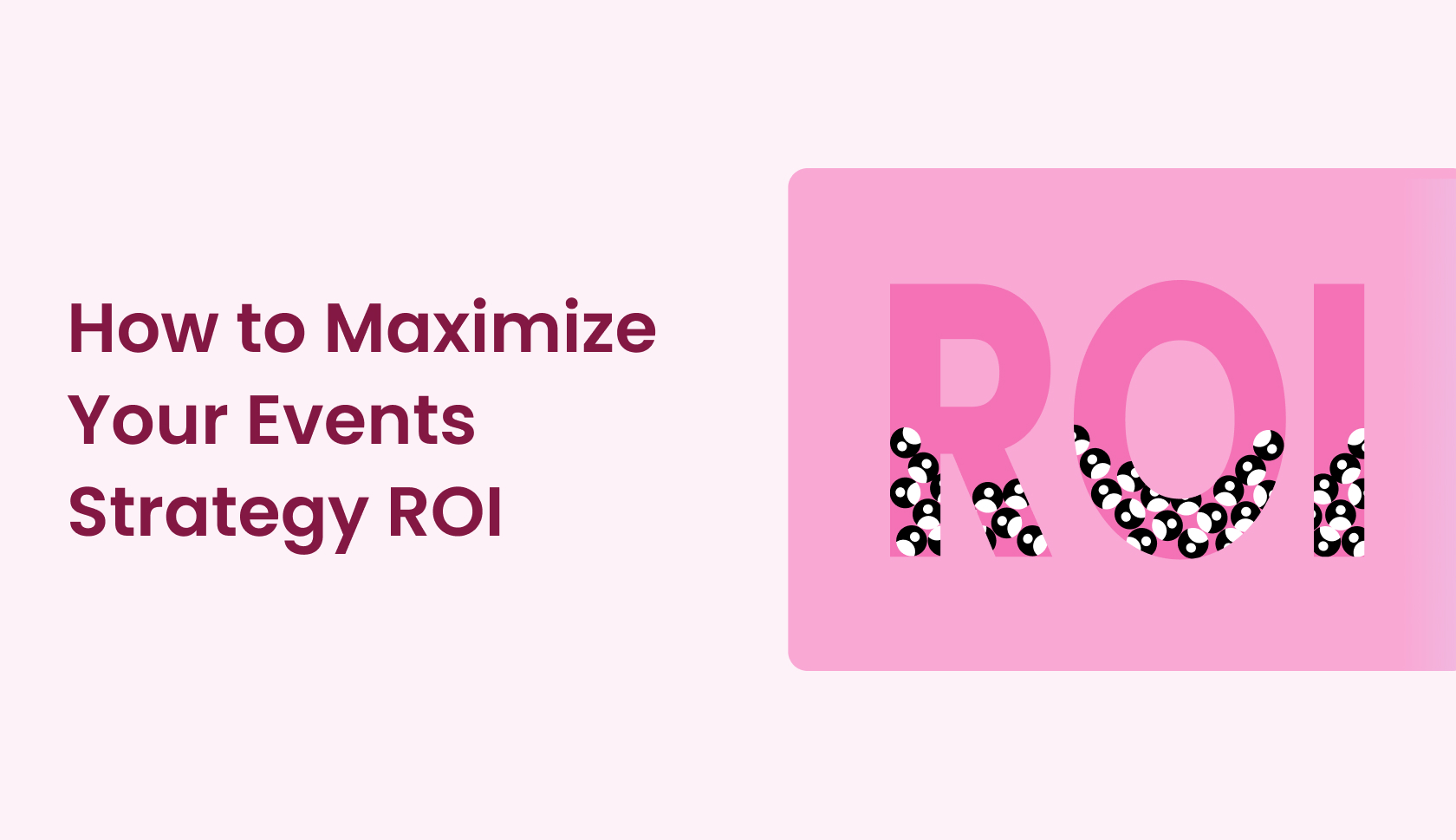
How to Maximize Your ROI at Industry Events: 6 Steps to Sales & Marketing Success
Introduction
Industry events, conferences, and trade shows are excellent opportunities for your team to generate pipeline, build brand authority, and accelerate deals. But for many companies, the investment of time, travel, and sponsorship dollars makes industry events not worth the trouble for the ROI.
Why? Because success at events is rarely about showing up, but about strategic planning, precise execution, and timely follow-up.
This guide will arm your sales and marketing teams with proven strategies to maximize ROI at every event, from pre-registration to post-event pipeline acceleration.
Step 1: Evaluate and prioritize the right events
Sounds obvious, right? Why would anyone go to an event that isn’t right for their company? But with hundreds of industry events each year, it’s easy to default to the largest conferences or those you’ve attended before. But your goal isn’t simply facetime in the expo hall, but meaningful engagement with your ideal customers.
Key considerations when evaluating events:
- Attendee profile: Does the event attract your target personas and decision-makers?
- Speaker and session topics: Are the sessions relevant to your solution space, indicating that prospects will be thinking about challenges your product addresses?
- Past sponsor and exhibitor lists: Do your competitors or partners regularly participate? This indicates market relevance.
- Event format: Is it virtual, hybrid, or fully in-person? Tailor your team’s approach accordingly.
Step 2. Set measurable objectives
Define what success looks like for each event. Each company’s full objective list will vary, but here are a few key things to consider:
- Number of net new qualified leads added to the pipeline
- Number of meetings booked with existing prospects to advance deals
- Customer or partner relationship touchpoints
- Brand awareness metrics such as booth visits, demo attendance, or content downloads
Setting clear goals enables alignment across sales, marketing, and leadership, making sure everyone is working toward measurable business outcomes.
Step 3. Develop your pre-event outreach strategy
The weeks leading up to an event are your highest leverage period. Booking meetings before the event starts will fill up your team’s calendars with targeted conversations ahead of time rather than relying on unpredictable booth traffic.
Best practices:
- Use AI SDRs to identify registrants who match your ICP and automate personalized outreach at scale.
- Reference specific event sessions, topics, or speakers that align with each contact’s interests to boost meeting acceptance rates.
- Collaborate with marketing to include meeting CTAs in pre-event campaigns, sponsored content, or social posts.
Step 4. Enable your team with actionable insights
Provide every member attending the event with:
- Detailed contact profiles: Including recent interactions, open opportunities, and key pain points.
- Strategic talking points: Tailored to common challenges your prospects face, and aligned with your product’s value propositions.
- Clear roles and responsibilities: For booth coverage, scheduled meetings, and networking events.
Leverage your AI sales tools to centralize insights and automate briefing reports for each meeting, saving time and increasing meeting quality.
Step 5. Execute with focus and flexibility
During the event, your team should:
- Proactively engage attendees rather than waiting for booth visits
- Capture notes and insights immediately after each conversation in your CRM
- Attend key sessions to gain market intelligence and spark relevant conversations
- Stay alert! Nothing says “don’t visit this booth” like a team who looks bored.
Encourage a culture of adaptability. Opportunities often develop outside official meetings, like dinners or informal gatherings.
Step 6. Optimize your post-event follow-up process
The window immediately after the event is critical for converting interest into pipeline.
Post-event follow-up essentials:
- Segment leads based on interest level and conversation context
- Personalize outreach sequences, referencing specific discussions from the event
- Prioritize speed; the sooner you follow up, the more memorable and relevant you remain
- Use AI SDRs to automate tailored follow-ups at scale, freeing reps to focus on the highest-priority opportunities
Conclusion
Industry events can be incredible growth drivers when you approach them strategically. With thoughtful preparation, precise execution, and timely follow-up, your team can turn each event into a tangible pipeline accelerator.
Discover how Alta’s AI sales assistants can automate pre-event outreach and post-event follow-up to maximize ROI from every conference your team attends.
Frequently Asked Questions
What metrics should I track to measure event ROI?
Track these metrics for event ROI:
- Revenue vs. total costs (core ROI)
- Attendance & engagement (registrations, participation)
- Leads generated & conversions
- Attendee satisfaction (NPS, survey feedback)
- Sponsor value (leads, satisfaction)
- Cost per attendee
- Key marketing stats (traffic, conversions)
- Social media reach
ROI formula:
(Total Returns−Total Costs)/Total Costs×100(Total Returns−Total Costs)/Total Costs×100
How early should my sales team start event outreach?
Your sales team should start event outreach 8–12 weeks before the event for the best results—especially for large or high-value events.
- Begin preparations early: plan your target list, craft outreach messages, and segment key prospects.
- Start initial outreach at least 2–3 months in advance to allow for multiple touchpoints and personalized follow-ups, increasing engagement and conversion odds.
- For high-profile or VIP attendees, or if the sales cycle is long, consider beginning even earlier.
- Complement outreach with multi-channel campaigns (email, LinkedIn, calls, ads) and coordinate with marketing to maximize pre-event awareness.
Early, systematic outreach is critical for booking meetings, advancing deals, and maximizing event ROI.
Which event types generate the highest pipeline ROI?
The event types that generate the highest pipeline ROI are:
- Executive roundtables (average ROI: 423%): Top performer for deal size increase, especially effective for enterprise companies and strategic account focus.
- Customer conferences (annual events): High ROI (average 287%), major driver of retention and expansion revenue.
- In-person trade shows and large conferences: Consistently cited as most effective for generating sales pipeline and accelerating deals, particularly in B2B markets.
- Product demos and launches: High ROI (average 156%), strong for sales acceleration and new pipeline creation.
- Targeted workshops and seminars: Deliver efficient pipeline acceleration and nurture mid/final-funnel leads, especially in verticals like marketing tech.
- Webinars: Best for top-of-funnel lead generation with lower cost per opportunity, but typically impact smaller deal sizes than high-touch in-person events.
Focus on in-person or highly targeted executive/customer events for maximum pipeline impact, supplemented by webinars for scalable lead generation.
How can marketing help sustain post-event momentum?
Marketing plays a crucial role in keeping the energy and engagement alive after an event. Here’s how:
- Lead Segmentation & Scoring: Prioritize follow-ups by segmenting leads based on how they engaged during the event.
- Personalized Follow-ups: Send thank-you emails with session recordings, resources, or special offers tailored to attendee interests.
- Content Sharing: Keep event content visible by sharing highlight reels, blog summaries, infographics, and social media posts.
- Lead Nurturing Campaigns: Use marketing automation to guide prospects through the sales funnel with targeted messaging.
- Social Proof: Encourage attendees to share their experiences and testimonials to build ongoing conversations.
- Data-Driven Improvements: Use event feedback and data to refine future marketing and measure ROI.
- Stakeholder Reporting: Provide post-event reports to sponsors and stakeholders to showcase event impact and gain future support.
This ongoing, personalized, multi-channel approach ensures maximum lead conversion and long-term brand engagement beyond the event itself.
What’s a realistic ROI percentage to expect?
A typical event marketing ROI ranges from 25% to 34% depending on the industry and type of event. Many marketers report seeing a 3:1 return on investment, meaning for every dollar spent, they make about three dollars back. Some studies also show event ROI can range broadly from 200% to 500% (2x to 5x return), especially if you include longer-term sales influenced by the event. Actual ROI depends on factors like event goals, audience engagement, industry, and how well you track and leverage leads.
What are effective pre‑event strategies to maximize return on investment?
What are best practices for maximizing event ROI in the post‑event follow‑up phase?

.png)
.png)




